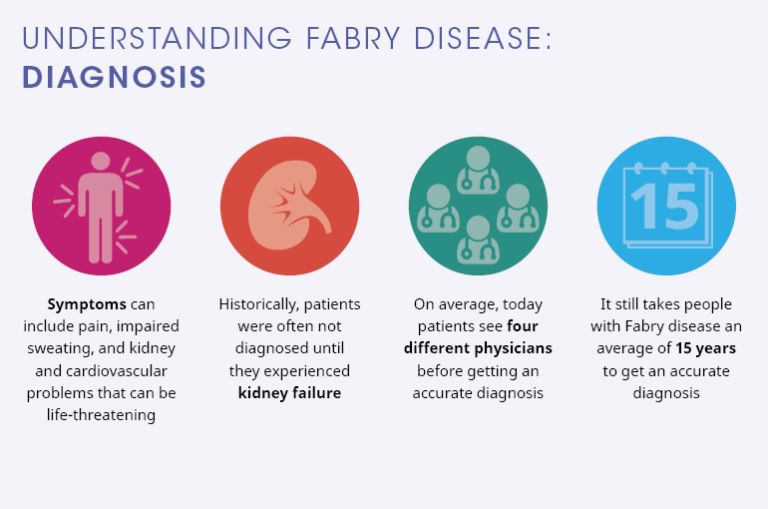Fabry disease (FD) is an X-linked glycosphingolipid lysosomal storage disorder, which affects approximately 1 in 40 000 – 117 000 males. Female patients may have different manifestations of the disease, although its prevalence in females is unknown. If left untreated, FD may lead to multiple organ failure, and life expectancy of such patients may be reduced by up to 20 years, compared to the general population.
FD is caused by pathological variants of the GLA gene. The known mechanism of FD is related to the GLA product, alpha-galactosidase A enzyme. Its absent or deficient activity causes glycosphingolipids accumulation in different cells and tissues, which leads to a variety of clinical manifestations. The classic phenotype may be present from childhood and includes neuropathic or limb pain provoked by various triggers, benign skin lesions, corneal opacities, GI, and nonspecific symptoms. The involvement of renal, cardiovascular, and cerebrovascular systems causes the majority of outcomes.
The facts that this disease is rare, and its symptoms are not specific, contribute to misdiagnose or not considering FD by medical specialists. The diagnostic is widely available and includes molecular genetic testing, alpha-Gal A activity assay, and sometimes tissue or organ biopsies. Considering that the therapy is highly expensive (US$150–US$250K per year), it is essential to estimate the organ involvement and the treatment response. While the reliability of some approaches for such purposes is under investigation now (for example, detection of glycosphingolipids in body fluids), the authors of a recent paper published in the Journal of Medical Genetics decided to investigate an alternative diagnostic approach.
Doykov I.D. et al. used the multiple reaction monitoring approach, based on the liquid chromatography-tandem mass spectrometry. They developed a proteomics assay able to detect 41 proteins in 1mL of urine and tested it with biomaterial of 66 recruited patients with the confirmed FD. The proteins were selected based on the previous proteomic experiments or considered to reflect the organs affected by FD.
The analysis of these biomarkers in different organs involvement showed that 20 of them correlated with pathological changes in organs and might be considered for the following investigations. Besides, the analysis revealed that these biomarkers could be divided into several groups, to support the diagnostics of FD, including the asymptomatic/early-stage patients, and to monitor the treatment response or disease progression. Further studies may confirm the relevance of these biomarkers in different cohorts of FD diagnosed patients; also, these promising findings could stimulate scientist to develop proteomic assays for other lysosomal storage diseases.
If this approach and the selected biomarkers will prove to be reliable, we can receive the new rapid and non-invasive diagnostic tool for clinical decision making in patients suspected or confirmed for FD.
References:
- Doykov ID, Heywood WE, Nikolaenko V, et al Rapid, proteomic urine assay for monitoring progressive organ disease in Fabry diseaseJournal of Medical Genetics Published Online First: 13 September 2019. http://dx.doi.org/10.1136/jmedgenet-2019-106030
- https://www.sanofigenzyme.com/en/about-us/our-stories/living-with-fabry-disease-then-and-now
Additional information on the topic:
- Fabry disease https://ghr.nlm.nih.gov/condition/fabry-disease
- Fabry disease https://www.orpha.net/consor/cgi-bin/OC_Exp.php?Expert=324&lng=EN
- Fabry disease: Clinical features and diagnosis https://www.uptodate.com/contents/fabry-disease-clinical-features-and-diagnosis




